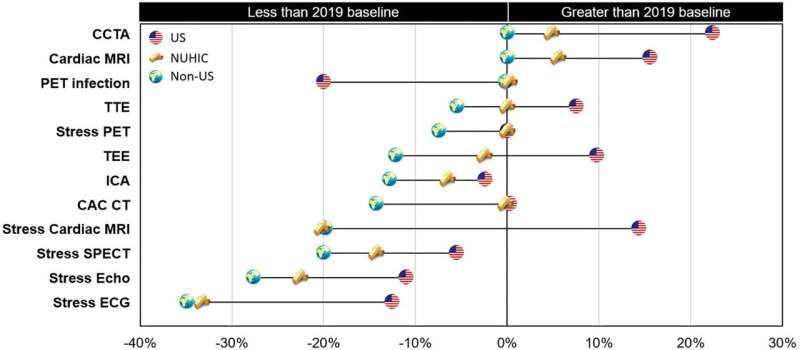
Change in diagnostic cardiovascular testing in 2021 compared with prepandemic procedure baseline volumes. Chart compares the median percentage change in procedure volumes of U.S. (represented by U.S. flag), NUHIC (represented by gold bars), and all non-U.S. (represented by world globe) facilities from March 2019 to April 2021. Percentage change represents the median of the percentage change values of all individual facilities in each category. Procedure types on the vertical axis are shown in descending order of percentage change for all non-U.S. facilities. CAC=coronary artery calcium, CCTA=coronary CT angiography, ECG=electrocardiography, Echo=echocardiography, ICA=invasive coronary angiography, NUHIC=non-U.S. high-income country, TEE=transesophageal echocardiography, TTE=transthoracic echocardiography. Credit: Radiology: Cardiothoracic Imaging (2023). DOI: 10.1148/ryct.220288
Declines in cardiovascular procedure volumes observed early in the COVID-19 pandemic greatly recovered in 2021 in the U.S. and other high-income countries, but not in facilities in lower-income countries, according to a study published in Radiology: Cardiothoracic Imaging.
“Cardiovascular disease remains the leading cause of death for both men and women,” said lead researcher Andrew J. Einstein, M.D., Ph.D., director of nuclear cardiology, cardiac CT and MRI, and professor of medicine at Columbia University Irving Medical Center, New York. “Diagnostic procedures are imperative for the timely diagnosis and risk stratification of patients with suspected cardiovascular disease.”
Dr. Einstein and a team of researchers evaluated data collected by the International Atomic Energy Agency (IAEA) through the Non-invasive Cardiology Protocols Study of COVID-19 (INCAPS COVID and INCAPS COVID 2). The worldwide studies collected data from 669 facilities in 107 countries to determine the impact of the pandemic on diagnostic cardiovascular procedure volumes.
With 93 centers across 34 U.S. states participating, the study is one of the largest analyses of diagnostic cardiovascular procedures in the U.S. published to date.
Participating facilities reported diagnostic imaging volumes during March 2019 (baseline), April 2020 (early pandemic period), and April 2021 (recovery period).
Using the INCAPS COVID 2 data, the researchers evaluated the procedure volumes before, during and after the pandemic. The team also performed a statistical analysis on the factors associated with a return to pre-pandemic volumes in the U.S.
U.S. facilities submitted procedure volumes totaling 262,691, and non-U.S. centers submitted volumes totaling 930,235. Baseline procedure volume per center was higher for U.S. facilities compared with all non-U.S. facilities (951 versus 222) and non-U.S. high-income country (NUHIC) facilities (951 versus 300).
The worldwide volume of cardiothoracic imaging procedures decreased by 64% in April 2020 compared to March 2019. By 2021, low- and low-middle-income countries reported persistent and substantial declines in procedure volumes compared to 2019, while all other countries, including the U.S., reported procedure volumes near or at prior 2019 baseline volumes. Regional recovery in the U.S. was lowest in the South and West.
According to Dr. Einstein, the availability of telemedicine services and policies may have been one of the factors playing a role in the recovery. U.S. facilities reported a two-fold greater use of telehealth services compared with NUHIC facilities.
“Though further studies are needed to gauge the long-term impact of increased telehealth use on patient outcomes, studies have already shown that telehealth is associated with increased patient satisfaction, improved patient retention, and improved access to care for a wide range of patient populations and communities,” he said.
Dr. Einstein said a multi-faceted approach is needed to address potential excess morbidity and mortality from cardiovascular disease in economically disadvantaged regions, including strategies such as improving access to cardiovascular care including resources for diagnosis and treatment, improving health care worker training and increasing telehealth infrastructure.
More information:
Cole B. Hirschfeld et al, Cardiovascular Testing in the United States during the COVID-19 Pandemic: Volume Recovery and Worldwide Comparison, Radiology: Cardiothoracic Imaging (2023). DOI: 10.1148/ryct.220288
Citation:
Low-income country cardiac imaging procedures remain down post-COVID (2023, September 21)
retrieved 21 September 2023
from https://medicalxpress.com/news/2023-09-low-income-country-cardiac-imaging-procedures.html
This document is subject to copyright. Apart from any fair dealing for the purpose of private study or research, no
part may be reproduced without the written permission. The content is provided for information purposes only.
>>> Read full article>>>
Copyright for syndicated content belongs to the linked Source : Medical Xpress – https://medicalxpress.com/news/2023-09-low-income-country-cardiac-imaging-procedures.html






























